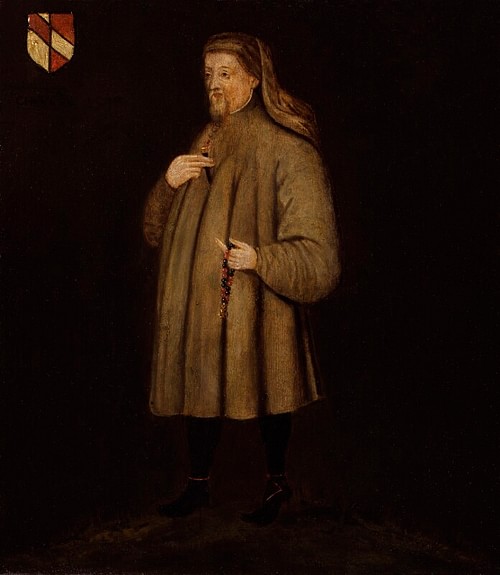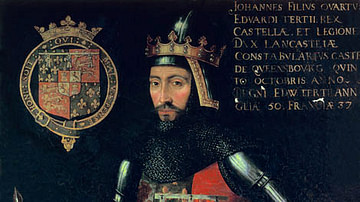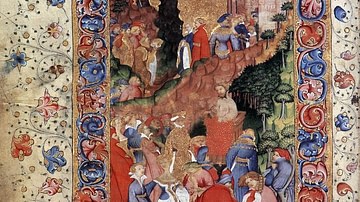
The Canterbury Tales (written c. 1388-1400 CE) is a medieval literary work by the poet Geoffrey Chaucer (l. c. 1343-1400 CE) comprised of 24 tales related to a number of literary genres and touching on subjects ranging from fate to God's will to love, marriage, pride, and death. After the opening introduction (known as The General Prologue), each tale is told by one of the characters (eventually 32 in all) who are on pilgrimage to the shrine of Thomas Becket in Canterbury.
In The General Prologue, the characters agree to tell two stories going to Canterbury and two coming back to the Tabard Inn at Southwark where they started from, totaling 120 tales. If this was Chaucer's original plan and he never intended to deviate from it, then the piece must be considered unfinished at only 24 tales. Some scholars claim, however, that Chaucer did finish the work, based on the tone and subject matter of the last tale and The Retraction appended to the manuscript.
The Canterbury Tales was popular centuries before it was actually published in c. 1476 CE. There are more copies of this manuscript than any other full-length medieval work except the penitential poem The Prick of Conscience, also from the 14th century CE, which was only so frequently copied due to its use by the Church. The Canterbury Tales is considered Chaucer's masterpiece and is among the most important works of medieval literature for many reasons besides its poetic power and entertainment value, notably its depiction of the different social classes of the 14th century CE as well as clothing worn, pastimes enjoyed, and language/expressions used. The work is so detailed and the characters so vividly rendered that many scholars contend it was based on an actual pilgrimage Chaucer took c. 1387 CE. This seems unlikely, however, as Chaucer held a full-time position from the king at that time and any travels would have been noted in court records.
Chaucer's Life & Career
Geoffrey Chaucer was the son of a wealthy wine merchant of London, given a good education at local schools, and entered into service of the royal court around the age of 13 in 1356 CE. He served under three English kings, King Edward III (r. 1327-1377 CE), Richard II (r. 1377-1399 CE), and Henry IV (also known as Henry Bolingbroke, r. 1399-1413 CE) in positions ranging from page to soldier, courier, valet and esquire, controller of the customs house of the London port, member of parliament, and court clerk and poet, among other duties.
Chaucer's works were never technically published during his lifetime as that concept had not yet been invented but he was well known and highly regarded as a poet as his works were copied by other scribes who then shared or sold them. The events of his life are well documented in court records, and it is known he was recognized for his poetic achievements by Edward III (who granted him a gallon of wine daily for life for what was most likely a poetic composition) and rewarded financially by John of Gaunt, Duke of Lancaster (l. 1340-1399 CE) for composing his first major work, The Book of the Duchess (c. 1370 CE) in honor of John of Gaunt's late wife Blanche.
By the time Chaucer began composing The Canterbury Tales, he was at the height of his poetic powers and had traveled and read widely. He was fluent in Latin, French, and Italian, but wrote in the vernacular of Middle English. The characters who appear in The Canterbury Tales are drawn from Chaucer's life experiences and are probably amalgams of people he had known (though some, like Harry Bailey the Innkeeper, are historical individuals) and Chaucer's use of Middle English to tell their stories is particularly effective since he is able to render their various accents and dialects as they would have sounded at the time.
Characters
Chaucer, appearing as one of the characters in the story, describes the others when he meets them at the Tabard Inn at Southwark. The majority of the characters will tell a tale to the others as they ride toward Canterbury. These are, in the order they appear in The General Prologue:
- Chaucer-the-pilgrim who narrates the work; tells the 17th and 18th tales
- The Knight – a man of honor, truth, and chivalry; tells the 1st tale
- The Squire - the knight's son, a gentle youth of poetic sensibilities; tells the 11th tale
- The Yeoman – the knight's servant; no tale
- The Prioress (Madame Eglentyne) – a nun who supervises a priory; tells the 15th tale
- The Second Nun – secretary to the Prioress; tells the 21st tale
- The Nun's Priest – one of three priests traveling with the Prioress; tells the 20th tale
- The Monk – a worldly lover of hunting, riding, and drinking; tells the 18th tale
- The Friar (Huberd) – a corrupt clergyman who keeps donations for himself; tells the 7th tale
- The Merchant – a somber man who distrusts women; tells the 10th tale
- The Clerk – a scholar from Oxford University; tells the 9th tale
- The Sergeant of the Law (Man of Law) – a wealthy lawyer; tells the 5th tale
- The Franklin (landowner) – a glutton, companion of Man of Law; tells the 12th tale
- The Five Tradesmen: Haberdasher, Carpenter, Weaver, Dyer, and Tapestry Weaver, all traveling together; described in General Prologue but no speaking parts
- The Cook (Roger) – works for the above tradesmen, loves to drink; tells 4th tale
- The Shipman – a ship's captain; tells 14th tale
- The Doctor of Physic (physician) – a greedy astrologer; tells 13th tale
- The Wife of Bath (Alisoun) – a widow who has survived five husbands and traveled the world; tells 6th tale
- The Parson – a devout and honest clergyman; tells the 24th (last) tale
- The Plowman – the Parson's brother, devout and charitable; no speaking part
- The Miller (Robyn) – coarse, rough, and fond of drinking and stealing; tells the 2nd tale
- The Manciple (caterer) – purchases food for establishments; tells the 23rd tale
- The Reve (Osewald) – manager of an estate, an accountant; tells the 3rd tale
- The Summoner – server of summons to ecclesiastical courts; tells the 8th tale
- The Pardoner – seller of indulgences (pardons) and fake holy relics, rides with the Summoner; tells the 14th tale
- The Host (Harry Bailey) – Innkeeper at the Tabard where the pilgrims begin their journey, proposes the story-telling contest and moderates/settles disputes
- The Canon's Yeoman – not introduced in the General Prologue; meets the pilgrims along the way; tells 22nd tale
Brief Summary & Best-Known Tales
The Canterbury Tales is narrated by a character whom scholars identify as Chaucer-the-pilgrim, a literary character based on the author but presented as far more naïve, clueless, and trusting than the actual Chaucer could have been. This same sort of narrator appears in Chaucer's earlier works, The Book of the Duchess, The House of Fame (c 1378-1380 CE), and The Parliament of Fowls (c. 1380-1382 CE).
Chaucer-as-pilgrim takes the other characters at face value and seems to admire them even when they are obviously very poor specimens of humanity. A reader understands the kinds of people this pilgrim is encountering through the skill of Chaucer-the-poet who reveals the characters through their speech, the type of story they choose to tell, interaction with other characters, and what they say of themselves, all highlighting their habits, interests, vices, and virtues.
The poem opens with a grand description of springtime and nature stirring to life after the winter. This renewal inspires people to go on pilgrimage to the shrine of Thomas Becket, aka St. Thomas Beckett at Canterbury, one of the most popular pilgrimages in medieval Britain. Chaucer-as-pilgrim is at the Tabard Inn at Southwark, about to set out alone on this pilgrimage, when the others arrive to spend the night. He talks to them all at the communal dinner, and they invite him to travel with them. Their host, Harry Bailey, suggests they pass the time on the road with a story-telling contest. Each pilgrim will tell two stories on the way to Canterbury and two on the return; whoever tells the best story will win a free meal.
The next morning, they all set off and the knight is chosen to speak first. The other pilgrims are either chosen by Harry Bailey (referred to as The Host) or insist on speaking next and interrupt whoever was chosen. Chaucer-the-poet gives Chaucer-the-pilgrim two of the worst tales and also makes fun of himself in the Prologue to the Man of Law's Tale in which he has the character complain that every tale he can think of has already been told, however poorly, by Chaucer.
Among the best-known tales are the Miller's, the Nun's Priest's, and the Wife of Bath's although many of the others are of equal quality. The Miller's Tale is a fabliau, a form of French literature usually bawdy, satiric, and misogynistic in that wives especially, and women in general, are depicted as lusty, unfaithful, and devious. The French fabliau is among the genres the writer Christine de Pizan (l. 1364-c. 1430 CE) objected to in her work, and she would have no doubt extended this criticism to The Miller's Tale if she had known of it. This story is one of the bawdiest in the collection but is among those most often anthologized due to the brilliance of the plot and its seamless execution.
The Miller tells his tale in response to the knight's tale of romance, love, chivalry, and the ways of fortune. The Miller's Tale features the dim-witted John the Carpenter, his young wife Alisoun, the scholar Nicholas who rents a room from them, and the parish clerk Absolon. Nicholas and Alisoun are frustrated because they have no opportunity to consummate their affair since John is always around so Nicholas convinces John that a second Great Flood is coming soon and the only way to prepare for it is to suspend three wooden tubs by ropes from the ceiling of the house which they will each sleep in every night; when the Flood comes, they will float easily to safety. John installs the tubs and, when it is time for bed, all three climb into their respective tubs, John goes to sleep, and Nicholas and Alisoun go back downstairs and to bed.
At this same time, Absolon has been pining for Alisoun and has gotten her to agree to giving him a kiss, but when he raises his face to the bedroom window, Alisoun sticks her behind out and he kisses that. Nicholas and Alisoun laugh at Absolon who runs off to get a hot poker for revenge. He returns and asks for another kiss, and this time Nicholas puts his behind out the window, farts in Absolon's face, and Absolon jabs him with the poker. Nicholas screams for water as he races through the house, and this wakes John who thinks the Flood is upon him, cuts the ropes, and plunges to the floor, shattering his tub and breaking his arm. The neighbors hear all the commotion and come running to help but, after hearing the story, they dismiss John as crazy.
The Nun's Priest's Tale is a fable on the dangers of pride and flattery set in a farmyard. The proud rooster Chauntecleer has a dream that his life will be threatened by the fox, Daun Russel. He tells the dream to his wife, Pertelote, who dismisses it and tells him to go about his business as he always has or else he will lose the respect of the hens in the yard who so admire him. One day, Chauntecleer is out for a walk and Daun Russel comes by and flatters him, asking if he will sing him a song in his beautiful voice. Chauntecleer closes his eyes, stretches out his neck, and opens his beak to crow when the fox snatches him up in his jaws and runs into the woods. The whole barnyard follows in pursuit and Chauntecleer suggests to Daun Russel that perhaps he would like to pause to tell them their hope is lost and they should go back. When the fox follows this suggestion and opens his mouth, the rooster flies up onto a tree branch and escapes.

The Wife of Bath is the best-known character from The Canterbury Tales and her prologue is better known and most often cited than her tale. She has traveled all over the world, has had five husbands, and recognizes that God has given everyone something they are best at and, for her, it is sex. She talks about each of her husbands and about her travels, ignoring or dismissing the complaints of some of the pilgrims who want her to get on with her tale, and makes it a point to highlight how she was the master in each of her marriages.
Her tale then picks up on his theme as she relates the story of a knight of King Arthur's court who rapes a maiden and is sentenced to death. Queen Guinevere intervenes and tells the knight he will be pardoned if, in a year, he can return and tell her and her ladies what it is that women want most of all. The knight accepts these terms and leaves, spending the next year asking women what they want the most, but all the answers are subjective (money, honor, nice dresses, freedom). He is on his way back to court when he meets an old woman who says she knows the answer to his quest and will tell him if he promises to grant her a favor, which he does. Back at court, the knight tells the queen and her ladies the answer: what women want most is mastery over their husbands. Guinevere and her court agree and the knight is freed.
The old woman then requests her favor: she and the knight are to be married instantly. The service is performed, and the couple goes to their new home. That night, the woman asks the knight which he would prefer, that she remain old and ugly but be faithful or become young and beautiful but cause him always to doubt her loyalty. The knight answers that whichever choice pleases her most is fine with him, and the lady, satisfied that she has mastered her husband, becomes the young and beautiful bride but promises to also be faithful.
The pilgrims take their turn telling stories, argue, and interrupt, some so drunk they cannot speak or fall off their horse, until the Parson tells the last tale just as the sun is setting. His speech is not a tale but a dissertation on the Seven Deadly Sins and the value of a penitent heart. He points out that human beings the world over are all pilgrims, traveling between birth and death and going on to the afterlife. While he speaks, the sun goes down, and the party approaches a town for the night. The work then ends with The Retraction in which Chaucer repents for all his major works, including The Canterbury Tales, and hopes God will forgive him.
Conclusion
The final tale and the retraction have led some scholars to conclude that The Canterbury Tales is a finished work. Scholar Larry D. Benson, for example, writes:
The Retraction leaves us in no doubt that, unfinished, unpolished, and incomplete as The Canterbury Tales may be, Chaucer is finished with it. One wonders if a more finished, more nearly perfect version could have been any more satisfying. (22)
There is no consensus, however, on what The Retraction means or whether it was even intended to be included in the manuscript of The Canterbury Tales. No version of the work exists in Chaucer's own hand, all extant versions are copies and copies of copies, in which scribal errors alter who tells a tale, the tales appear in different order, or some do not appear at all. The most complete copy, The Ellesmere Manuscript (15th century CE) is the one most commonly used for modern-day editions of the work and includes The Retraction (as do many others) and so most scholars agree The Retraction was part of the original manuscript. Still, scholars who believe the work was left unfinished at Chaucer's death cite the plan outlined in The General Prologue and the non-speaking characters (such as the Plowman) who should have been given a tale as proof Chaucer never completed the work.
Whatever its state of completion, The Canterbury Tales has been entertaining and fascinating audiences since it was written. More than any of Chaucer's other works, the Tales validated the use of Middle English in vernacular writing as it brought the characters and their stories to life. Popular fiction of the Middle Ages was written in French verse before Chaucer elevated Middle English poetry to the same height of popularity.
His characters became as real to readers as their family, friends, and neighbors, and the work was copied again and again long before it was published in c. 1476 CE. Although his earlier works had earned him fame and the respect of his fellow poets and members of the court, The Canterbury Tales would make Chaucer immortal as the author of one of the greatest works in English and grant him the honorable epithet of Father of English Literature.







